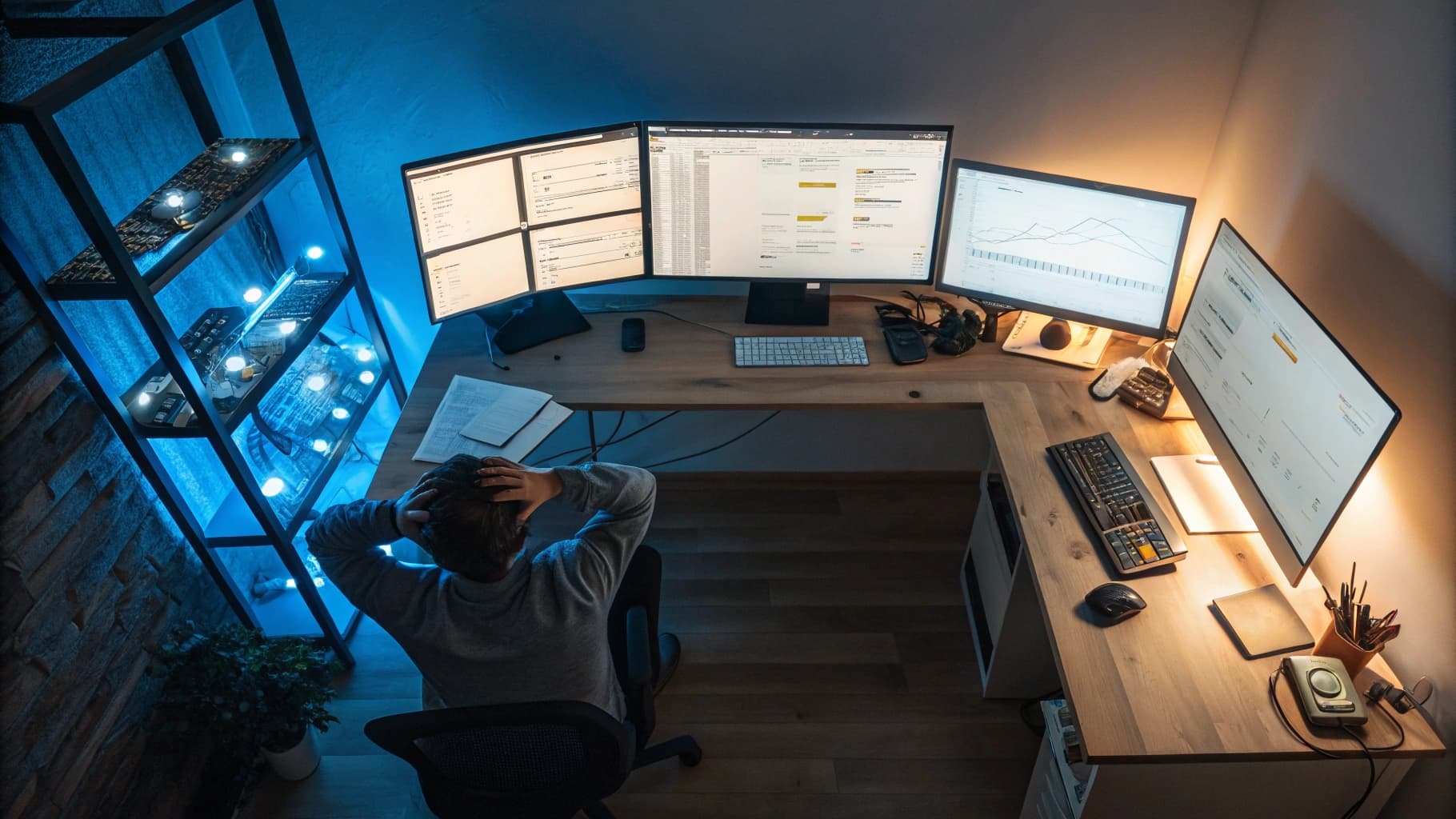In today’s fast-paced digital world, I find myself surrounded by screens more than ever before. Whether I’m at work, home, or even on the go, the presence of multiple screens has become a defining characteristic of my daily life. From smartphones and tablets to laptops and desktop computers, these devices have transformed the way I consume information, communicate, and perform tasks.
The concept of a multi-screen environment refers to the simultaneous use of more than one screen, allowing me to engage with various forms of media and applications at the same time. This phenomenon has not only changed how I interact with technology but has also raised questions about its effects on my attention span, cognitive load, and overall productivity. As I navigate through this multi-screen landscape, I often wonder about the implications of such an environment on my mental processes.
The convenience of accessing information across multiple platforms is undeniable; however, I also recognize that this constant connectivity can lead to challenges. The allure of multitasking can be tempting, but it often comes with a price. Understanding the dynamics of multi-screen environments is essential for me to harness their benefits while mitigating potential drawbacks.
In this article, I will explore the effects of multi-screen environments on attention span, cognitive load, distractions, task switching, and productivity, as well as strategies for managing these challenges effectively.
The Effects of Multi-Screen Environments on Attention Span
The Decrease in Attention Span
Studies indicate that the average attention span has decreased significantly in recent years, largely due to the influence of technology. The ability to switch between screens and applications may create an illusion of productivity, but it often results in fragmented attention.
The Distractions of Multi-Screen Environments
The temptation to check notifications or switch to another application can be overwhelming. Each ping or alert pulls me away from my primary task, making it increasingly difficult to engage deeply with the content at hand. This constant shifting of focus not only hampers my productivity but also affects my comprehension and retention of information.
Developing Strategies for Enhanced Focus and Efficiency
As I grapple with these challenges, I realize that understanding the impact of multi-screen environments on my attention span is crucial for developing strategies to enhance my focus and efficiency.
The Impact of Multi-Screen Environments on Cognitive Load
Cognitive load refers to the amount of mental effort required to process information and complete tasks. In a multi-screen environment, I often find myself juggling various streams of information simultaneously, which can lead to an overwhelming cognitive load. The brain has a limited capacity for processing information, and when I overload it with multiple sources of data, I risk diminishing my overall performance.
This phenomenon is particularly evident when I attempt to absorb information from one screen while responding to messages or notifications on another. I’ve come to realize that the cognitive demands of a multi-screen environment can lead to mental fatigue. As I switch between tasks and screens, my brain works harder to keep up with the influx of information, which can result in decreased efficiency and increased stress levels.
This heightened cognitive load not only affects my ability to think critically but also impairs my decision-making skills. To combat this issue, I must be mindful of how I engage with multiple screens and strive to create a more balanced approach that allows me to manage my cognitive resources effectively.
Distractions and Multi-Screen Environments
Distractions are an inherent part of multi-screen environments, and I often find myself battling them daily. With notifications constantly popping up and the temptation to check social media or browse the web, staying focused on a single task becomes increasingly challenging. Each distraction pulls me away from my primary objective, leading to a cycle of interrupted work that can be frustrating and counterproductive.
The allure of instant gratification from checking messages or scrolling through feeds can easily derail my concentration. Moreover, I’ve noticed that distractions in a multi-screen environment can create a sense of urgency that further complicates my ability to focus. The fear of missing out on important updates or conversations drives me to constantly check my devices, even when I know it detracts from my productivity.
This behavior not only disrupts my workflow but also contributes to a heightened sense of anxiety as I struggle to keep up with the demands of multiple screens. Recognizing these distractions is the first step toward developing strategies that allow me to minimize their impact and regain control over my attention.
Multi-Screen Environments and Task Switching
Task switching is another significant aspect of multi-screen environments that affects my productivity. As I move between different applications and screens, I often find myself engaged in a constant cycle of switching tasks rather than focusing on one at a time. While multitasking may seem efficient at first glance, research indicates that frequent task switching can lead to decreased performance and increased time spent on each task.
I’ve experienced this firsthand; every time I shift my focus from one screen to another, it takes time for my brain to recalibrate and re-engage with the new task. The cognitive cost associated with task switching is something I’ve become increasingly aware of in my daily routine. Each transition requires mental effort and can lead to errors or oversights as I struggle to regain my focus.
This realization has prompted me to reconsider how I approach my work in a multi-screen environment. By recognizing the limitations of task switching and its impact on my efficiency, I can make more intentional choices about how I allocate my time and attention across different screens.
Multi-Screen Environments and Productivity
The Dark Side of Multitasking
However, this potential for increased productivity is often undermined by the distractions and cognitive overload that accompany multi-screen use. While multi-screen environments can facilitate multitasking, they can also lead to diminishing returns in terms of productivity. The constant interruptions from notifications and the mental strain of managing multiple tasks can result in longer completion times for projects.
Finding a Balance
To maximize productivity in a multi-screen environment, I must strike a balance between leveraging the advantages of technology while being mindful of its pitfalls. By setting boundaries around screen use and prioritizing focused work sessions, I can enhance my productivity without succumbing to the distractions inherent in a multi-screen world.
Conclusion
Ultimately, the key to maximizing productivity in a multi-screen environment lies in finding a balance between technology and self-awareness. By being mindful of the potential distractions and taking steps to mitigate them, I can harness the power of multi-screen environments to enhance my productivity.
Strategies for Managing Multi-Screen Environments
To navigate the challenges posed by multi-screen environments effectively, I’ve developed several strategies that help me manage my attention and productivity. One approach is to establish designated times for checking notifications or engaging with social media rather than allowing these distractions to interrupt my workflow continuously. By setting specific intervals for checking messages or updates, I can maintain focus on my primary tasks without feeling overwhelmed by constant interruptions.
Another strategy involves creating a structured workspace that minimizes distractions from multiple screens. For instance, I’ve found that organizing my digital workspace by closing unnecessary tabs or applications helps reduce cognitive load and allows me to concentrate better on the task at hand. Additionally, utilizing tools such as website blockers or focus apps can help me stay committed to my work without succumbing to the temptation of browsing unrelated content.
Lastly, practicing mindfulness techniques has proven beneficial in managing the effects of multi-screen environments on my attention span and cognitive load. Taking short breaks to engage in deep breathing exercises or mindfulness meditation allows me to reset my focus and recharge mentally before returning to my tasks. By incorporating these strategies into my daily routine, I can create a more balanced approach to navigating the complexities of multi-screen environments.
Finding a Balance in Multi-Screen Environments
In conclusion, navigating multi-screen environments presents both opportunities and challenges for me as an individual striving for productivity in a digital age. While these environments offer unparalleled access to information and facilitate multitasking, they also pose risks related to attention span, cognitive load, distractions, and task switching. Recognizing these challenges has been instrumental in shaping my approach toward technology use.
Ultimately, finding a balance in multi-screen environments requires intentionality and self-awareness. By implementing strategies that prioritize focus and minimize distractions, I can harness the benefits of technology while safeguarding my mental well-being. As I continue to adapt to this ever-evolving digital landscape, I remain committed to cultivating habits that promote productivity without sacrificing clarity or concentration in my work life.
FAQs
What is a multi-screen environment?
A multi-screen environment refers to a setting in which an individual is using multiple electronic devices or screens simultaneously, such as a computer, smartphone, and television.
How does a multi-screen environment impact mental focus?
Research has shown that engaging with multiple screens at once can lead to decreased mental focus and cognitive performance. The brain may struggle to process and prioritize information, leading to reduced attention and productivity.
What are the potential consequences of prolonged exposure to multi-screen environments?
Prolonged exposure to multi-screen environments has been linked to increased feelings of stress, anxiety, and mental fatigue. It can also contribute to a decline in overall mental well-being and quality of sleep.
How can individuals mitigate the negative impact of multi-screen environments on mental focus?
Some strategies to mitigate the negative impact of multi-screen environments include setting boundaries for screen time, taking regular breaks, practicing mindfulness, and engaging in activities that promote mental clarity and relaxation, such as meditation or exercise.
Are there any benefits to using multi-screen environments?
While there are potential drawbacks, multi-screen environments can also offer benefits such as increased access to information, improved multitasking abilities, and enhanced productivity for certain tasks. However, it is important to balance these benefits with the potential impact on mental focus and well-being.

